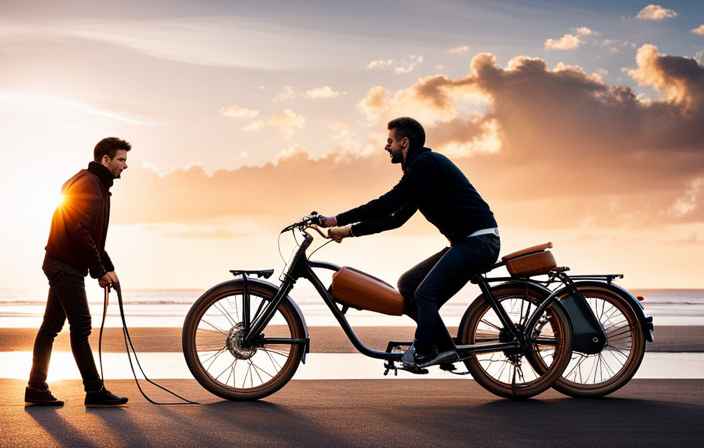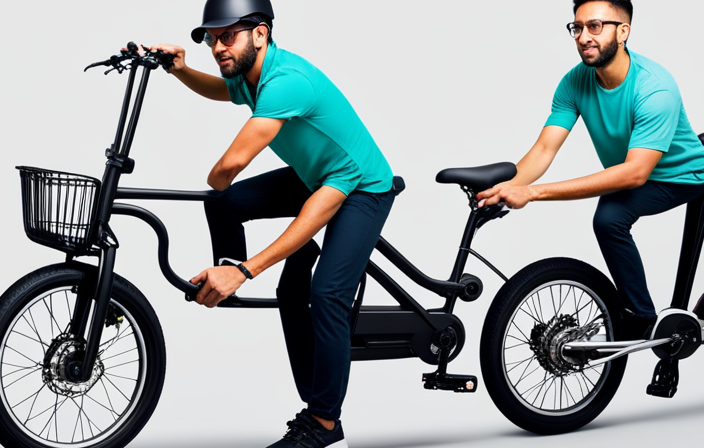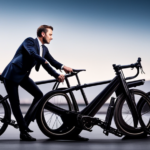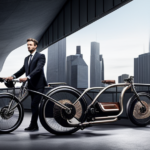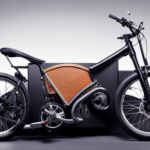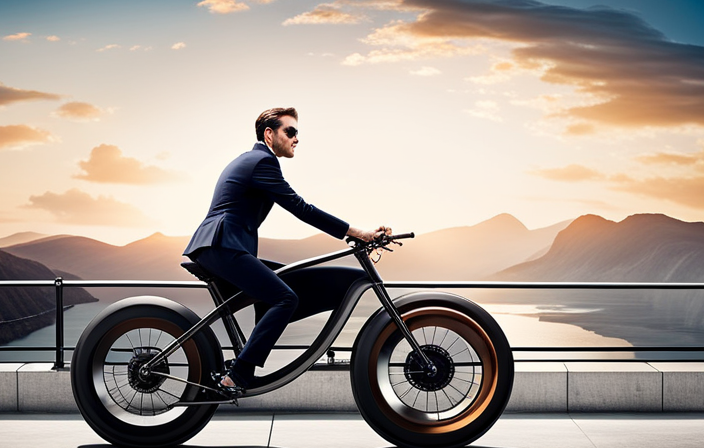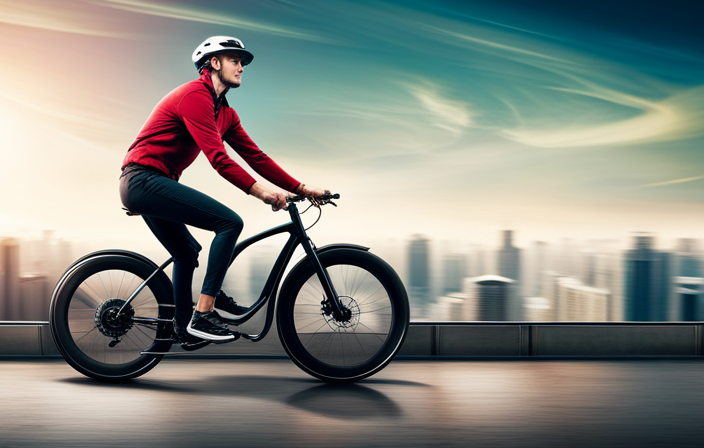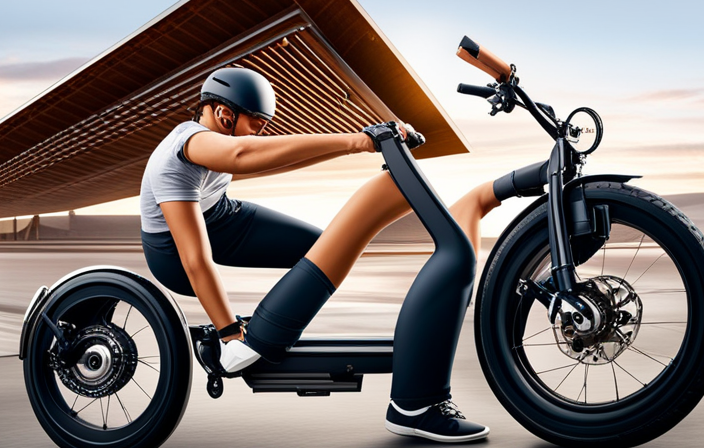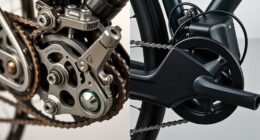I have always been intrigued by the concept of converting a gasoline motorcycle to electric. It is akin to revitalizing an old companion, providing it with a cleaner and more efficient energy source.
In this article, I’ll walk you through the step-by-step process of converting your petrol bike to electric. We’ll assess your bike’s suitability, research and choose the right conversion kit, gather the necessary tools, and more.
Get ready to embark on an electrifying journey to a greener future!
Key Takeaways
- Assess the bike’s overall condition and check for any structural damage or mechanical issues before starting the conversion process.
- Consider the battery options available, such as lithium-ion batteries for higher energy density and longer lifespan, or lead-acid batteries for affordability but shorter lifespan.
- Compare different conversion kits for compatibility with the bike model, considering factors like motor power, battery capacity, and performance.
- Ensure proper installation and connection of the electric motor and controller, and conduct thorough testing and troubleshooting before regular use.
Assess Your Bike’s Suitability for Conversion
Before you start the conversion process, it’s important to assess whether your bike is suitable for conversion to electric. Assessing your bike’s condition is crucial to ensure a successful conversion. Start by evaluating the overall condition of your bike, checking for any structural damage or mechanical issues. Make sure the frame is sturdy and in good shape, as it will need to support the additional weight of the electric components.
Next, consider the battery options for your electric conversion. There are several types of batteries available, each with its own advantages and limitations. Lithium-ion batteries are popular due to their high energy density and longer lifespan. However, they can be expensive. Lead-acid batteries are a more affordable option, but they are heavier and have a shorter lifespan. It’s important to evaluate your budget, desired range, and weight limitations when choosing the right battery for your conversion.
Once you have assessed your bike’s condition and evaluated battery options, you can move on to the next step of the conversion process: researching and choosing the right conversion kit.
Research and Choose the Right Conversion Kit
Once you’ve done your research, it’s important to choose the right conversion kit for your project. The research process is crucial as it allows you to gather information about the different conversion kits available in the market.
To begin, I recommend starting with a comparison of conversion kits. Look for kits that are compatible with your bike model and have positive customer reviews. Consider factors such as motor power, battery capacity, and overall performance. Look for kits that offer easy installation and come with all the necessary components. Additionally, consider the warranty and after-sales support offered by the manufacturer. This will ensure that you have assistance in case you encounter any issues during or after the conversion process.
By comparing different conversion kits, you can make an informed decision and choose the one that best suits your needs and budget. Once you have selected the right conversion kit, you can move on to the next step: gathering the necessary tools and equipment. This will include items such as wrenches, screwdrivers, wire cutters, and electrical tape. Having these tools ready will make the installation process smoother and more efficient.
With the right conversion kit chosen and the necessary tools gathered, you are now ready to proceed with the conversion process.
Gather the Necessary Tools and Equipment
To gather the necessary tools and equipment, make sure you have wrenches, screwdrivers, wire cutters, and electrical tape on hand. These tools are essential for the conversion process of turning a petrol bike into an electric one. Wrenches will be needed to loosen and tighten bolts, while screwdrivers will come in handy for removing screws and other fasteners. Wire cutters are essential for cutting and stripping electrical wires, and electrical tape will be used to insulate and secure the connections. Additionally, it is recommended to have a multimeter to test electrical components and identify any potential issues.
Having the right tools and equipment is crucial for a successful conversion process. Without them, you may encounter difficulties and delays. Therefore, it is important to ensure that you have all the necessary tools and equipment before starting the conversion.
Once you have gathered everything you need, you can proceed to the next step of disconnecting and removing the petrol engine. This step is crucial as it will pave the way for installing the electric components and making the necessary modifications to the bike. By properly disconnecting and removing the petrol engine, you will be ready to embark on the exciting journey of converting your petrol bike to an electric one.
Disconnect and Remove the Petrol Engine
Make sure you have all the necessary tools and equipment before proceeding with removing and disconnecting the petrol engine. This step is crucial in the process of converting your petrol bike to electric. Once you have everything you need, you can begin by following the steps below:
- Start by disconnecting the battery to ensure safety during the process.
- Remove the fuel tank and drain any remaining petrol from it.
- Disconnect the fuel lines and remove the carburetor from the engine.
- Loosen and remove the bolts securing the engine to the frame of the bike.
- Carefully lift the engine out of the bike, ensuring not to damage any surrounding components.
It’s important to consider disposal options for the petrol engine. One option is to sell it to someone who may have use for it or donate it to a local mechanic or workshop. Another option is to recycle it at a designated facility. Conducting a cost analysis will also help determine if it makes financial sense to sell or recycle the engine.
With the petrol engine successfully removed, you can now transition into the subsequent section about installing the electric motor and controller.
Install the Electric Motor and Controller
Now that the petrol engine has been removed, it’s time to install the electric motor and controller. This step is crucial in converting your petrol bike to electric. The electric motor will be the powerhouse that propels your bike forward, while the controller will regulate its speed and performance.
When it comes to choosing the right electric motor, there are a few factors to consider. First, you need to determine the power output you require for your bike. This will depend on factors such as the weight of your bike and the desired speed and range. Additionally, you need to consider the type of motor – whether it’s a brushless DC motor or a permanent magnet motor – based on your preferences and budget.
Once you have selected the appropriate motor, it’s time to install it. This involves securely mounting the motor onto the bike frame, ensuring that it is properly aligned with the chain or belt drive. The controller, on the other hand, needs to be positioned in a well-ventilated area to prevent overheating.
With the electric motor and controller installed, the next step is to connect the batteries and wiring. This will provide the necessary power for the motor to function.
Connect the Batteries and Wiring
Once the electric motor and controller are securely installed, it’s time to connect the batteries and wiring to provide power. This step is crucial in ensuring that your converted electric bike functions properly. Here’s a detailed guide on how to connect the batteries and wiring:
-
Wire connections:
-
Begin by identifying the positive and negative terminals on your batteries. These are usually labeled or color-coded.
-
Connect the positive terminal of one battery to the negative terminal of the next battery using heavy-duty battery cables.
-
Repeat this process until all the batteries are connected in series.
-
Finally, connect the positive terminal of the last battery to the positive terminal of the controller, and the negative terminal of the last battery to the negative terminal of the controller.
-
Battery placement:
-
Find a suitable location on your bike to mount the batteries. Consider factors such as weight distribution and accessibility for maintenance.
-
Securely attach the batteries using brackets or straps to prevent any movement or damage during rides.
-
Ensure that the battery placement does not interfere with other components of the bike, such as the suspension or handlebars.
By following these guidelines, you will have successfully connected your batteries and wiring, providing the necessary power for your electric bike.
Now, let’s move on to the next section, where we discuss how to modify the frame and suspension if necessary to accommodate the electric components without compromising the bike’s stability and safety.
Modify the Frame and Suspension if Necessary
If needed, you can modify the frame and suspension to accommodate the electric components without compromising the bike’s stability and safety. When converting a petrol bike to electric, it is important to ensure that the frame and suspension can handle the additional weight and power of the electric components.
To customize the aesthetics of your electric bike, you may need to make modifications to the frame. This can involve reinforcing certain areas to provide additional support and strength. It is crucial to consult with a professional or an experienced electric bike conversion specialist to determine the specific modifications needed for your bike’s frame.
Additionally, the suspension may need to be adjusted to account for the weight distribution of the electric components. This can help maintain the bike’s stability and ensure a smooth and comfortable ride. Upgrading the suspension system with stronger components or adjusting the existing suspension settings can help optimize the bike’s performance.
Install the Charging System
To install the charging system, you’ll need to ensure that the necessary components are properly connected and secured. Charging system installation is a crucial step in the process of converting a petrol bike to electric. Not only does it allow you to recharge your electric bike, but it also plays a vital role in the overall charging infrastructure development.
Firstly, you’ll need to select a suitable charging port for your electric bike. There are various options available, including wall-mounted chargers and portable chargers. Once you have chosen the appropriate charging port, you’ll need to connect it to the battery pack. Make sure to follow the manufacturer’s instructions and ensure that all connections are secure.
Next, you’ll need to install a charging controller. This device regulates the charging process and ensures that the battery pack is charged safely and efficiently. Connect the charging controller to the charging port and the battery pack, following the provided wiring diagram.
Lastly, it is essential to check the connections and secure all the components properly. Loose connections can lead to malfunctioning or even damage to the charging system.
With the charging system installed, you can now move on to the next step of the conversion process: test and fine-tune the electric conversion. This will allow you to ensure that all components are functioning correctly and make any necessary adjustments for optimal performance.
Test and Fine-Tune the Electric Conversion
Now that you have the charging system installed, it’s time to test and fine-tune your electric conversion for optimal performance. Electric conversion testing is a crucial step in the process to ensure that your converted bike meets your expectations and operates safely.
The fine-tuning process involves making adjustments and modifications to various components of the conversion to improve its efficiency and overall performance.
To begin the testing phase, you should first check all the connections and wiring to ensure they are secure and properly connected. This will help prevent any potential issues during the testing process.
Next, you should fully charge the batteries and ensure that they are functioning correctly.
Once the batteries are charged, it’s time to take your converted bike for a test ride. Start by gradually increasing the throttle and observing how the bike accelerates and maintains its speed. Pay attention to any unusual noises, vibrations, or handling issues that may arise. This will help you identify any areas that need adjustment or improvement.
During the fine-tuning process, you may need to make adjustments to the controller settings, throttle response, or regenerative braking system. This can be done by referring to the manufacturer’s instructions or seeking guidance from experienced electric vehicle enthusiasts.
In conclusion, electric conversion testing and fine-tuning are essential steps to ensure that your converted bike operates smoothly and efficiently. By carefully testing and making necessary adjustments, you can optimize the performance of your electric conversion.
Now, let’s move on to the next section, where we will discuss how to ensure safety measures and compliance with regulations.
Ensure Safety Measures and Compliance with Regulations
To ensure your safety and comply with regulations, it’s important to familiarize yourself with the necessary safety gear and legal requirements for operating your converted vehicle. Ensuring safety compliance is crucial when converting a petrol bike to electric.
Before hitting the road, conduct a thorough risk assessment to identify potential hazards and address them appropriately.
First and foremost, invest in safety gear such as a helmet, gloves, and protective clothing to protect yourself in case of an accident. Additionally, ensure that your converted vehicle meets all the legal requirements set by your local authorities. This may include obtaining the necessary permits, registering the vehicle, and displaying the appropriate license plates.
Furthermore, it is essential to assess the risk associated with the electrical components of your conversion. Make sure all the wiring is properly insulated and secured to prevent any short circuits or electrical malfunctions. Consider installing a circuit breaker or fuse to protect against overloading and minimize the risk of fire.
By taking these safety measures and complying with regulations, you can enjoy a safe and legal ride on your converted electric bike.
Now, let’s delve into the exciting possibilities of upgrading your vehicle and exploring accessories for optimal performance.
Consider Upgrades and Accessories for Optimal Performance
When it comes to enhancing your ride and maximizing performance, you’ll want to consider various upgrades and accessories.
Two key areas to focus on are upgrading batteries and enhancing aerodynamics.
Upgrading your bike’s batteries is crucial for increasing its range and overall performance. Lithium-ion batteries are the most popular choice due to their high energy density and long lifespan. These batteries provide more power and can be recharged quickly, ensuring a smooth and efficient ride.
Additionally, enhancing your bike’s aerodynamics can greatly improve its speed and efficiency. This can be achieved by installing a fairing, which reduces drag and improves airflow around the bike. Other accessories that can help improve performance include lightweight rims, high-performance tires, and a streamlined body kit.
By investing in these upgrades and accessories, you can transform your bike into a high-performance electric vehicle.
Now that you’ve learned about upgrading and enhancing your bike, let’s move on to the next section where we will explore maintenance and troubleshooting to ensure your electric bike remains in top condition.
Learn about Maintenance and Troubleshooting
If you want to keep your e-bike in top condition, it’s important to learn about maintenance and troubleshooting. Regular maintenance will not only prolong the life of your electric bike but also ensure optimal performance. Let’s take a look at some common maintenance issues and how to troubleshoot them:
| Common Maintenance Issues | Troubleshooting Common Problems | Solution |
|---|---|---|
| Battery not charging | Check if the charger is properly connected and functioning. | Ensure the charger is plugged in correctly and try a different power outlet. If the problem persists, contact customer support. |
| Reduced range | Check the tire pressure and ensure they are properly inflated. | Inflate the tires to the recommended pressure. If the issue persists, check for any drag or resistance in the drivetrain and consult a professional if needed. |
| Brakes not working | Check the brake pads for wear and tear. | Replace worn brake pads. If the problem persists, check the brake cables and adjust the tension accordingly. |
Familiarize Yourself with Electric Bike Laws and Regulations
Make sure you familiarize yourself with the laws and regulations surrounding e-bikes to ensure safe and legal riding. Understanding electric bike safety and the infrastructure that supports it is crucial for a smooth and enjoyable experience.
Here are some key points to keep in mind:
-
Know the speed limits: Different regions may have varying speed limits for e-bikes. Familiarize yourself with the maximum speed allowed in your area to avoid any legal complications.
-
Follow traffic rules: Treat your e-bike like any other vehicle on the road. Obey traffic signals, stay in your designated lane, and use hand signals when turning. This not only keeps you safe but also promotes a harmonious environment for all road users.
-
Wear protective gear: It’s essential to wear a helmet while riding an electric bike. Additionally, consider wearing reflective clothing and using lights to enhance your visibility, especially during low-light conditions.
By adhering to these guidelines, you can ensure your safety and the safety of others while enjoying the benefits of an electric bike.
Enjoy the Benefits of an Electric Bike
To fully embrace the advantages of an e-bike, you’ll love the ease of commuting and the freedom to explore without worrying about parking or traffic. Electric bikes offer numerous benefits that make them a great choice for transportation. Here are some key advantages of electric bikes and reasons why you should consider converting to electric:
| Advantages of Electric Bikes | Reasons to Convert to Electric |
|---|---|
| Zero Emissions | Environmentally friendly |
| Cost-effective | Save money on fuel |
| Low Maintenance | Less maintenance required |
| Health Benefits | Get exercise while commuting |
| Improved Accessibility | Conquer hilly terrains easily |
Electric bikes are environmentally friendly, emitting zero emissions and reducing your carbon footprint. They are also cost-effective, saving you money on fuel expenses. With lower maintenance requirements compared to petrol bikes, electric bikes offer convenience and long-term savings. Additionally, riding an electric bike provides health benefits as it allows you to incorporate exercise into your daily commute. Lastly, electric bikes offer improved accessibility, allowing you to effortlessly conquer hilly terrains that may have been challenging with a traditional bike.
Spread the Word and Inspire Others to Go Electric
By sharing my personal experience with the benefits of an e-bike, I can inspire others to switch to this greener form of transportation.
The impact of promoting sustainability through e-bikes cannot be overstated. Not only do they reduce carbon emissions, but they also offer numerous advantages over traditional bikes.
One of the key benefits is the assistance provided by the electric motor, which makes riding uphill or against the wind a breeze. This feature makes e-bikes accessible to a wider range of individuals, including those who may not have the physical strength or stamina to ride a regular bike.
Additionally, e-bikes can reach higher speeds, allowing for quicker and more efficient travel. They also offer the convenience of adjustable power levels, allowing riders to choose the level of assistance they need.
All these benefits combined make e-bikes an attractive option for commuting, recreational riding, and even exercise.
Frequently Asked Questions
Can I convert any type of petrol bike to electric?
Yes, any type of petrol bike can be converted to electric. Converting to electric offers numerous advantages, such as reduced pollution, lower operating costs, and a quieter ride. It also allows for a more environmentally friendly and sustainable mode of transportation.
How much does a conversion kit typically cost?
Conversion kit costs can vary depending on the brand and features, but a typical cost comparison shows that they range from $500 to $2000. The installation process involves removing the petrol engine and replacing it with the electric motor.
Do I need to have any technical knowledge or experience to perform the conversion?
Technical skills and knowledge are necessary to perform a bike conversion. Understanding electrical systems, battery placement, and motor integration is crucial. Additionally, specific tools like wrenches, pliers, and wire cutters are needed for a successful conversion.
How long does the conversion process usually take?
The conversion process usually takes around 20-30 hours, depending on the complexity of the project. Common challenges include sourcing compatible parts, modifying the bike’s frame, and integrating the new electric components seamlessly.
Are there any specific regulations or requirements I need to meet in order to legally ride an electric bike?
To legally ride an electric bike, there are specific regulations and requirements that must be met. These include obtaining a valid driver’s license, following traffic laws, wearing a helmet, and ensuring the bike meets safety standards.
Conclusion
After successfully converting my petrol bike to electric, I can confidently say that the process was worth the effort.
The benefits of an electric bike are astounding, and one statistic that highlights this is the fact that electric bikes emit zero tailpipe emissions, unlike their petrol counterparts.
This not only helps to reduce air pollution, but also contributes to a cleaner and healthier environment.
By going electric, we can make a significant impact on our surroundings and inspire others to do the same.
Let’s ride towards a greener future!
